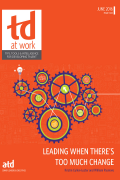The Public Manager Magazine Article
How to Beat Change Overload
A new issue of TD at Work gives advice for leaders whose organizations are dealing with constant change.
Wed Aug 10 2016

Federal government employees are all too familiar with change. Changing administrations and changing priorities, not to mention technology advancements and being asked to do more with less, all add stress to public employees' daily work routines.
As the June bonus issue of the Association for Talent Development's TD at Work points out, "Each of us has an 'emotional bank account' that contains the emotional energy we use to deal with the challenges life throws our way." Among those challenges are those found in the workplace, some of which are negative, some neutral, and some positive. Yet, even those positive changes create a short-term withdrawal from that emotional bank account.
"Leading When There's Too Much Change" offers guidance on how leaders and managers can soften the impact of change on employees. Specifically, they can:
Determine whether the current change overload is temporary or systemic.
Accept ownership for the overloaded state and responsibility for finding a solution.
Share the problem with employees. If the overload is temporary, invite employees to identify ways to outlast the challenging time period. When the change overload is long term, involve employees in determining how to reconsider the organization's strategy, systems, and ways of working.
Communicate the plan to reduce overload, with specifics about what has been decided.
Give employees permission to stop doing low-priority tasks.
In assessing the projects that are ongoing in a department or agency, leaders must analyze who is responsible for tasks and ensure that no one individual or small team is loaded with too many "high-priority" projects. The authors of this issue of TD at Work, Kristin Cullen-Lester and William Pasmore, provide four concrete actions that leaders can take to "do" change differently:
Discover. "You can't manage what's coming by looking in the rearview mirror," write Cullen-Lester and Pasmore. Take the time to attend conferences, discuss changes with fellow leaders, and expose yourself to topics that are beyond your normal work scope.
Decide. Scrutinize how work is being done in your agency—will it be efficient and effective in tomorrow's workplace? What's going well, and what could be done better? "To avoid overload and burnout, be realistic about how much you and others can handle." Consider again that emotional bank account.
Do. But don't try to do everything. Be willing to experiment. Don't expect perfection; instead, seek incremental change and progress toward goals and overall mission.
Discern. "Try new things and then dedicate time to assessing what you have learned. There will be things you wish to continue or spread more widely and other things that just don't work for you," advise the authors.
Two job aids—a "Burnout Assessment" and a tool for "Determining Root Causes of Overload"—are included in the issue.
Look inside the issue to learn more, including how organizations with effective and ineffective prioritization strategies operate.
